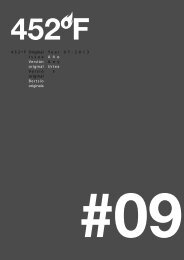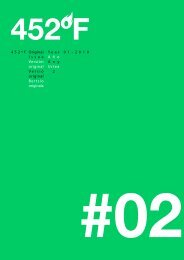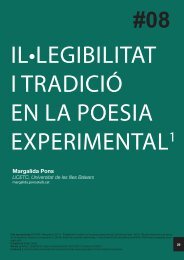03 - 452ºF
03 - 452ºF
03 - 452ºF
Create successful ePaper yourself
Turn your PDF publications into a flip-book with our unique Google optimized e-Paper software.
0. Introduction<br />
What are the connections between popular culture and women’s<br />
fiction? An obvious link is that both have long been in receipt of vast<br />
amounts of negative criticism. In A Theory of Mass Culture (1957),<br />
Dwight MacDonald stated that «Mass Culture began as, and to<br />
some extent still is, a parasitic, a cancerous growth on High Culture»<br />
(MacDonald, 1998: 23), while continuing on to complain that the rise<br />
in mass/popular culture has resulted in «serious ideas [competing]<br />
with commercialized formulae» (MacDonald, 1998: 24).<br />
Women’s fiction has typically received just as little respect; in fact,<br />
as Juliette Wells points out, there has been «a long tradition of<br />
discounting women writers and their readers» (Wells, 2006: 48).<br />
Much of this criticism has attempted to «justify the assumption that<br />
novels by women would be recognizably inferior to those by men»<br />
(Showalter, 2009: 63). Women’s literature has rarely received the<br />
recognition it deserves. Indeed, until relatively recent times, most<br />
female writers «were scorned by the male intellectual elite because of<br />
their «low-brow» appeal» (Rakow, 1998: 282). Additionally, women’s<br />
writing was virtually excluded from the literary Canon, while «critical<br />
issues of quality have been used to question the validity of writings<br />
by women, from the authenticity of their authorship [...] to the validity<br />
of what they write about and what they produce» (Warhol and Herndl,<br />
1997: 74).<br />
It has been said that «the intersection of “feminism” and “popular<br />
culture” has never been anything other than troubled» (Shiach,<br />
1998: 333), and, in terms of contemporary literature at least, this<br />
intersection takes the form of chick lit, the contemporary genre of<br />
fiction typically featuring female characters in their 20s and 30s as<br />
they make their way through their lives and tackle all the obstacles in<br />
their way, everything from finding Mr. Right (or, at least, Mr. Maybe)<br />
to finding the perfect career to finding the perfect shoes, along with<br />
everything in-between, all told in a humorous and self-deprecating<br />
tone. Elizabeth Merrick attempts to summarize the main plotlines of<br />
the typical chick lit novel in the following extract:<br />
Chick lit is a genre, like the thriller, the sci-fi novel, or the fantasy epic.<br />
Its form and content are, more or less, formulaic: white girl in the big<br />
city searches for Prince Charming, all the while shopping, alternately<br />
cheating on or adhering to her diet, dodging her boss, and enjoying the<br />
occasional teary-eyed lunch with her token Sassy Gay Friend. Chick lit<br />
is the daughter of the romance novel and the stepsister to the fashion<br />
magazine. Details about race and class are almost always absent except,<br />
of course, for the protagonist’s relentless pursuit of Money, a Makeover,<br />
and Mr. Right. (Merrick, 2006: 7-8)<br />
Trivial or Commendable? : Women’s Writing, Popular Culture, and Chick Lit - Mary Ryan<br />
<strong>452ºF</strong>. #<strong>03</strong> (2010) 70-84.<br />
72










